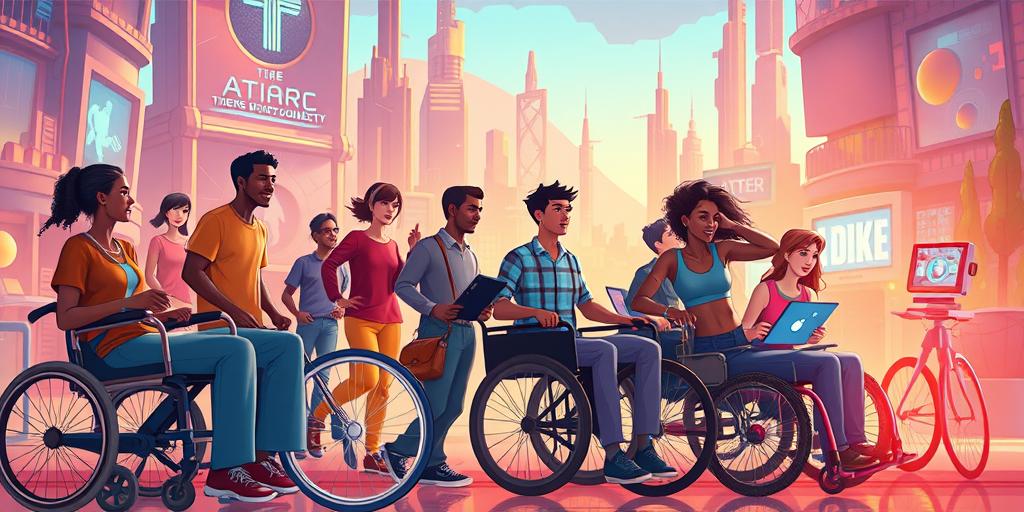Are you ready to be amazed by how technology is transforming the lives of people with disabilities? Prepare to be inspired! Emerging technologies are no longer a futuristic fantasy; they’re actively bridging the accessibility gap, creating a more inclusive world for everyone. From groundbreaking assistive devices to revolutionary software, the advancements are nothing short of incredible. This article will delve into the exciting ways these technologies are revolutionizing accessibility and making a real difference in people’s lives.
Assistive Technologies: Revolutionizing Daily Life
Assistive technology (AT) encompasses a wide range of devices and software designed to help people with disabilities perform tasks more easily. These tools aren’t just about making things possible; they are about empowering individuals to live more independent and fulfilling lives. Think beyond the basic wheelchair; we’re talking about sophisticated smart prosthetics controlled by brain signals, advanced screen readers that convert text to speech with incredibly natural intonation, and speech-to-text software that allows hands-free communication and document creation. The possibilities are constantly expanding.
Smart Prosthetics: The Future is Now
One of the most remarkable developments in assistive technology is the rise of smart prosthetics. These aren’t your grandparents’ prosthetics. We’re talking about advanced devices that integrate seamlessly with the body, offering unparalleled levels of control and functionality. Powered by artificial intelligence and advanced sensors, these prosthetics can respond to subtle muscle movements, providing near-natural dexterity and enabling users to perform tasks with incredible precision. This technology is not just restoring functionality; it’s enhancing it.
Screen Readers and Text-to-Speech Software: Breaking Down Communication Barriers
For visually impaired individuals, screen readers and text-to-speech software are invaluable. These technologies convert digital text into audible speech, allowing users to access information and interact with computers and other devices independently. Advanced features like natural language processing and voice control are further enhancing accessibility, making it easier than ever for people with visual impairments to participate fully in the digital world. Imagine the freedom and empowerment this technology provides.
Speech-to-Text Software: Empowering Communication
Speech-to-text software is another game-changer. This technology allows users to dictate text using their voice, eliminating the need for manual typing. This is particularly beneficial for individuals with motor impairments, allowing them to create documents, send emails, and communicate effectively without physical limitations. The accuracy and speed of these programs continue to improve, making them an increasingly essential tool for accessibility.
Artificial Intelligence: Unlocking New Possibilities for Accessibility
Artificial intelligence (AI) is playing a crucial role in advancing accessibility. AI-powered tools are being developed to address a wide range of challenges, from improving the accuracy of speech recognition to creating more intuitive and user-friendly interfaces. AI’s potential to personalize accessibility solutions based on individual needs is particularly exciting. The implications are transformative.
AI-Powered Image Recognition: Describing the World
AI-powered image recognition technology can describe images to visually impaired users, providing context and understanding of visual information. These tools can identify objects, scenes, and even emotions depicted in images, offering a richer and more engaging experience for visually impaired individuals. It’s like having a personal image interpreter always available.
AI-Driven Personal Assistants: Seamless Integration
AI-powered personal assistants, like Siri, Alexa, and Google Assistant, are increasingly becoming crucial tools for individuals with disabilities. These assistants can perform a wide variety of tasks, from setting reminders and making calls to controlling smart home devices and providing information. Their ability to understand and respond to natural language makes them exceptionally user-friendly.
AI in Assistive Robotics: Expanding Capabilities
The combination of AI and robotics is creating exciting new possibilities for assistive technologies. AI-powered robots can assist with tasks such as mobility, personal care, and household chores, enhancing independence and quality of life for individuals with disabilities. This technology is still in its early stages, but its potential is vast.
The Role of Inclusive Design in Accessibility
Inclusive design is a crucial aspect of creating truly accessible technology. It’s about designing products and services that are usable by people with a wide range of abilities and disabilities from the outset, rather than adding accessibility features as an afterthought. This approach leads to more intuitive and user-friendly designs for everyone. It’s about universal usability.
Universal Design Principles: Creating Accessible Experiences
Universal design principles emphasize creating products and environments that are usable by people with a wide range of abilities without the need for adaptation or specialized design. This approach ensures that accessibility is not just an add-on but an integral part of the design process.
Accessible Web Design: Ensuring Digital Inclusion
Accessible web design is critical for ensuring that people with disabilities can access information and services online. It involves using specific techniques and technologies to make websites compatible with assistive technologies, such as screen readers. Following accessibility guidelines, such as WCAG (Web Content Accessibility Guidelines), is essential for creating inclusive online experiences.
The Future of Accessibility: A Collaborative Effort
The future of accessibility depends on a collaborative effort among technologists, designers, policymakers, and individuals with disabilities. By working together, we can create a world where technology empowers everyone to reach their full potential. Continued investment in research and development, along with the adoption of inclusive design principles, is key to ensuring that technology serves as a bridge, not a barrier, to inclusion. Let’s build a more accessible and equitable future, together. The journey towards universal accessibility is ongoing and requires a collective commitment to innovation and inclusivity. Embrace the power of technology to create a more accessible world for all!
Ready to learn more about the incredible advancements in accessibility technology? Click here to explore our resources and discover how you can contribute to building a more inclusive world!




